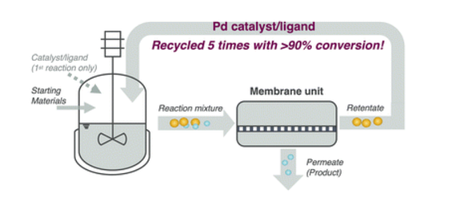

 A new open-access, peer-reviewed paper by ETERNAL industrial partner AstraZeneca demonstrates the effective recovery of homogeneous palladium catalysts from reaction mixtures using commercial organic solvent nanofiltration (OSN) membranes.
A new open-access, peer-reviewed paper by ETERNAL industrial partner AstraZeneca demonstrates the effective recovery of homogeneous palladium catalysts from reaction mixtures using commercial organic solvent nanofiltration (OSN) membranes.The paper presents a real pharmaceutical manufacturing case study to synthesize AZD4625, a potent and selective inhibitor of KRASG12C, without altering the existing catalyst/ligand system. Despite the inherent challenges, the recovered catalyst and ligand were successfully reused up to five times, maintaining a conversion rate of over 90%. Furthermore, life cycle assessment (LCA) showed that the sustainability of the process could be further enhanced by using greener bio-derived solvents and implementing solvent recovery to reduce solvent consumption.
Homogeneous catalysts are frequently used in the pharmaceutical industry but suffer from problematic separation from the reaction mixture and subsequent reuse. As an alternative to traditional separation methods like distillation and extraction, OSN shows great potential to address the challenge of efficiently recovering and reusing homogeneous catalysts, without high energy usage and cumbersome biphasic separation.
Featuring in the RSC journal Green Chemistry, the authors’ work demonstrates the application of OSN under industrially relevant conditions with high catalyst/product concentrations and using the green solvent 2-MeTHF, highlighting its practicality and environmentally friendly nature. LCA indicated that the OSN process using bio-derived 2-MeTHF has a carbon footprint comparable to the adsorption method using CUNO filters. Further sustainability gains can be achieved by integrating a solvent recovery unit to reduce solvent consumption of the OSN diafiltration process. Additionally, future research can extend the findings from this study to other pharmaceutical syntheses.
Read the full text open-access article at Green Chemistry
We are pleased to further celebrate the impact made by a previous AstraZeneca publication under the support of ETERNAL in connection with the application of OSN to green pharmaceutical processes. The review article ‘Organic Solvent Nanofiltration in Pharmaceutical Applications’ which appeared in OPR&D in March 2024 has received over 10,000 hits and been cited 16 times in the period of less than a year since it was published. This has ensured that this comprehensive review of recent progress of organic solvent nanofiltration and its applications in the pharmaceutical industry has become a firm fixture on OPR&D’s most read articles list, the journal’s Top 20 most downloaded articles for the previous 12 months.
This site uses cookies that enable us to make improvements, provide relevant content, and for analytics purposes. For more details, see our Cookie Policy. By clicking Accept, you consent to our use of cookies.